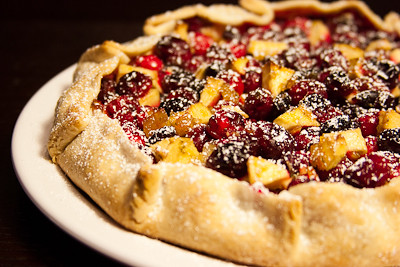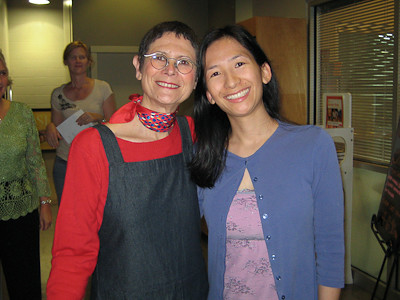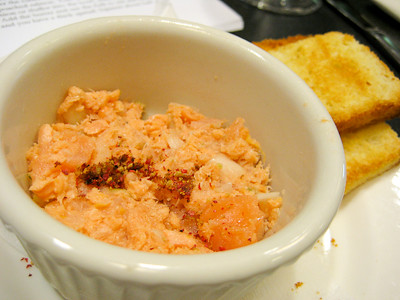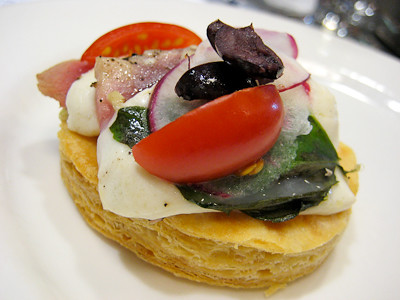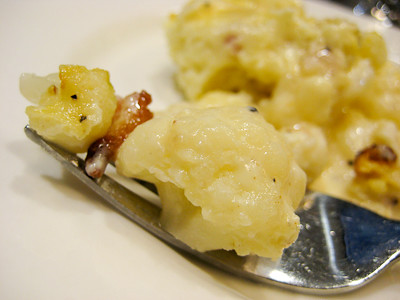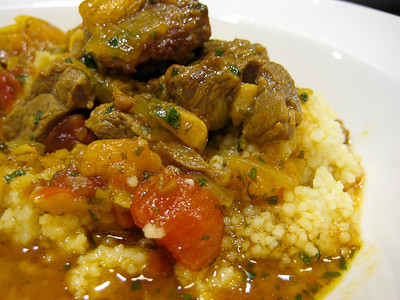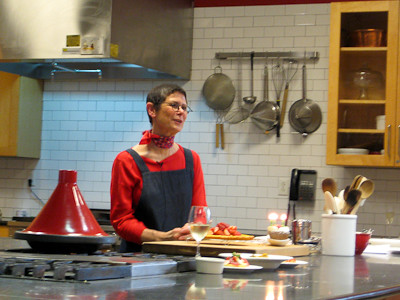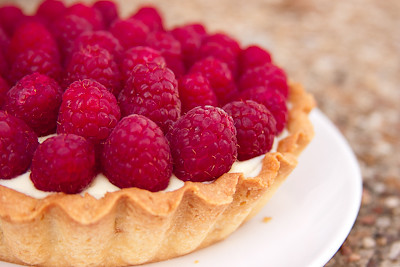
The 2010 November Daring Bakers’ challenge was hosted by Simona of briciole. She chose to challenge Daring Bakers’ to make pasta frolla for a crostata. She used her own experience as a source, as well as information from Pellegrino Artusi’s Science in the Kitchen and the Art of Eating Well.
I decided to make the Crostata di Frutta Fresca (crostata with fresh fruit). I filled my tart with Dorie's vanilla pastry cream and then topped it with fresh raspberries. The dough came together quickly and easily, but I thought it was just okay. It was a little too hard and not buttery enough in my opinion. My favorite tart dough is still Dorie's sweet tart dough - it's so buttery and flaky and almost melts in your mouth.
Thanks Simona, for hosting this month's challenge. My post is a day late and kind of short because I've been busy! Between Thanksgiving on Thursday and my daughter's 1st birthday party yesterday (photos to come), I've been running around the kitchen like crazy. I finally got around to making the tart today and now I'm exhausted!
Make sure you check out the Daring Bakers' Blogroll to see how everyone else enjoyed these sweet Italian treats.
Crostata (Italian tart)
all photos below are from Simona
Version 1 of pasta frolla
Ingredients:- 1/2 c. minus 1 tablespoon [105 ml, 100 g, 3 ½ oz] superfine sugar (see Note 1) or a scant 3/4 cup [180ml, 90g, 3 oz] of powdered sugar
- 1 and 3/4 cup [420 ml, 235 g, 8 1/4 oz.] unbleached all-purpose flour
- a pinch of salt
- 1 stick [8 tablespoons / 4 oz. / 115 g] cold unsalted butter, cut into small pieces
- grated zest of half a lemon (you could also use vanilla sugar as an option, see Note 2)
- 1 large egg and 1 large egg yolk, lightly beaten in a small bowl
Note 2: There are different ways of making vanilla sugar. I keep vanilla beans in a jar half-filled with sugar until I need to use them, for example, to make vanilla ice cream. After I remove the split bean from the custard that will go into the ice cream maker, I rinse it, dry it and put it back in the jar with sugar.
Making pasta frolla by hand:
- Whisk together sugar, flour and salt in a bowl.
- Rub or cut the butter into the flour until the mixture has the consistency of coarse crumbs. You can do this in the bowl or on your work surface, using your fingertips or an implement of choice.
- Make a well in the center of the mounded flour and butter mixture and pour the beaten eggs into it (reserve about a teaspoon of the egg mixture for glazing purposes later on – place in the refrigerator, covered, until ready to use).
- Add the lemon zest to your flour/butter/egg mixture.
- Use a fork to incorporate the liquid into the solid ingredients, and then use your fingertips.
- Knead lightly just until the dough comes together into a ball.
- Shape the dough into a flat disk and wrap in plastic wrap. Place the dough in the refrigerator and chill for at least two hours. You can refrigerate the dough overnight.



Making pasta frolla with a food processor:
- Put sugar, flour, salt, and lemon zest in the food processor and pulse a few times to mix.
- Add butter and pulse a few times, until the mixture has the consistency of coarse meal.
- Empty food processor's bowl onto your work surface
- See step 3 above and continue as explained in the following steps (minus the lemon zest, which you have already added).
If you want, you can make the pasta frolla using a combination of all-purpose flour and whole-wheat pastry flour.
If you choose to try this variation, use 1 cup [240 ml, 135 g, 4 3/4 oz.] unbleached all-purpose flour and 3/4 cup [180 ml, 100 g, 3.5 oz.] whole-wheat pastry flour.
Version 2 of pasta frolla
In this version of pasta frolla, I have played with different kinds of flours, using almond, whole-grain barley and, most recently, coconut flour instead of some of the all-purpose flour. If you want to try a different version of pasta frolla that uses some flours that you wouldn’t normally use, this is a good recipe to try. All the flours listed below (whole-wheat pastry, almond flour, coconut flour and barley flour) are available at health food stores. You may even find them at well-stocked supermarkets.The preparation for this version of pasta frolla is very similar to the preparation for Version 1.
Ingredients
- 1/3 cup [80 ml, 75 g, 2 2/3 oz.] superfine sugar or 1/2 cup [120ml, 60 g, 2 oz]powdered sugar (see Note 1.)
- 1/2 cup [120 ml, 65 g, 2 3/8 oz.] unbleached all-purpose flour
- 1/2 cup [120ml, 65 g. 2 1/4 oz.] whole-wheat pastry flour
- 1/4 cup [60ml, 28 g, 1 oz] almond flour, or almond meal, or coconut flour
- 1/4 cup [60ml, 28 g, 1 oz.] whole-grain barley flour or unbleached all-purpose flour
- a pinch of salt
- 6 tablespoons[90ml, 85 g, 3 oz] cold unsalted butter, cut into small pieces
- 1 large egg, lightly beaten
- 1/4 teaspoon vanilla extract (you can also use vanilla sugar; see Note 2.)
Note 2: There are different ways of making vanilla sugar. I keep vanilla beans in a jar half-filled with sugar until I need to use them, for example, to make vanilla ice cream. After I remove the split bean from the custard that will go into the ice cream maker, I rinse it, dry it and put it back in the jar with sugar.
Directions:
By hand:
- Whisk together sugar, flours and salt in a bowl.
- Rub or cut the butter into the sugar and flour mixture until it has the consistency of coarse crumbs. You can do this in the bowl or on your work surface, using your fingertips or an implement of choice.
- Make a well in the center of the flour and butter mixture and pour the beaten egg and vanilla extract into it.
- Use a fork to incorporate the liquid into mixture and then use your fingertips.
- Knead lightly just until the dough comes together into a ball.
- Shape the dough into a flat disk and wrap in plastic wrap. Place the dough in the refrigerator and chill for at least two hours. You can refrigerate the dough overnight.
- Put sugar, flour, and salt in the bowl of the food processor and pulse a few times to mix.
- Add butter and pulse a few times until the mixture has the consistency of coarse meal.
- Empty food processor's bowl onto your work surface.
- Make a well in the center of the mounded flour and butter mixture and pour the beaten egg and vanilla extract into it.
- Use a fork to incorporate the liquid into the solid ingredients then use your fingertips.
- Knead lightly just until the dough comes together into a ball.
- Shape the dough into a flat disk and wrap in plastic wrap. Place the dough in the refrigerator and chill for at least two hours. You can refrigerate the dough overnight.

Ideas for Filling for Your Crostata
Whether you choose to make Version 1 or 2 of the pasta frolla, there are numerous fillings that you can choose from for your crostata. I am suggesting some filling for you here (and including assemblage and baking instructions). But be brave and creative and see what you can come up with!Crostata di Marmellata (crostata with a jam filling using Version 1 pasta frolla)
If you choose to make a crostata with a jam filling, you will need:
- 1 and 3/4 cups [415ml, 600 gm, 21 oz] of jam or fruit preserves, whatever flavor you like (Note: I use my homemade fruit preserves, which have a low sugar content. I recommend you choose a good quality product, made with mostly fruit.)
- Heat the oven to 375ºF [190ºC/gas mark 5].
- Take the pasta frolla out of the fridge, unwrap it and cut away ¼ of the dough. Reserve this dough to make the lattice top of the crostata. Refrigerate this dough while you work on the tart base.
- To help roll the crostata dough, keep the dough on top of the plastic wrap that you had it wrapped in. This can help rolling the dough and can also help when transferring the dough to your pan. You can also use parchment paper for this. However, you can also roll the dough directly on a work surface if you prefer.
- Lightly dust the top of the dough and your work surface (if you’re rolling directly on a work surface) with flour. Keep some flour handy to dust the dough as you go along.
- If the dough is very firm, start by pressing the dough with the rolling pin from the middle to each end, moving the rolling pin by a pin's width each time; turn the dough 180 degrees and repeat; when it softens, start rolling.
- Roll the dough into a circle about 1/8th inch (3 mm) thick.
- If you used the plastic wrap or parchment paper as rolling surface, flip dough over the pan, centering it, and delicately press it all around so the corners are well covered. Peel away the plastic wrap.
- Trim the excess dough hanging over the edges of the pan. Press the remaining dough around the border into the sides of the pan making sure the border is an even thickness all the way around.
- Prick the bottom of the dough with a fork in several places.
- Take out of the fridge the reserved pasta frolla you had cut away earlier. Roll it with your pin and cut into strips or use cookie cutters to make small shapes (this is not traditional, but it looks cute); or roll with your hands into ropes.
- Spread the jam or fruit preserves evenly over the bottom of the crostata.
- Use the prepared strips or rolls of dough to make a lattice over the surface, or decorate with the cut shapes. (Note: You can use dough scraps to make cookies: see the Additional Information section for some pointers)
- Brush the border and strips of dough with the reserved beaten eggs. You can add a drop or two of water to the beaten eggs if you don’t have enough liquid.
- Put the tart in the oven and bake for 25 minutes.
- After 25 minutes, check the tart and continue baking until the tart is of a nice golden hue. (Note: Every oven is different. In my oven it took 34 minutes to bake the tart until golden.)
- When done, remove the tart from the oven and let cool. If you have used a tart pan with a removable bottom, then release the tart base from the fluted tart ring. Make sure the tart is completely cool before slicing and serving.





Crostata con la Crema (crostata with pastry cream filling using Version 1 pasta frolla)

If you choose to make a crostata with pastry cream filling, you will need:
- One batch of pastry cream (Note: For the recipe that I used, see #5 of the Additional Information section. Prepare the pastry cream in advance of assembling the crostata.
- Heat the oven to 350ºF [180ºC/gas mark 4].
- Take the pasta frolla out of the fridge, unwrap it and cut away ¼ of the dough. Reserve this dough to make the lattice top of the crostata. Refrigerate this dough while you work on the tart base.
- To help roll the crostata dough, keep the dough on top of the plastic wrap that you had it wrapped in. This can help rolling the dough and can also help when transferring the dough to your pan. You can also use parchment paper for this. However, you can also roll the dough directly on a work surface if you prefer.
- Lightly dust the top of the dough and your work surface (if you’re rolling directly on a work surface) with flour. Keep some flour handy to dust the dough as you go along.
- If the dough is very firm, start by pressing the dough with the rolling pin from the middle to each end, moving the rolling pin by a pin's width each time; turn the dough 180 degrees and repeat; when it softens, start rolling.
- Roll the dough into a circle about 1/8th inch (3 mm) thick.
- If you used the plastic wrap or parchment paper as rolling surface, flip dough over the pan, centering it, and delicately press it all around so the corners are well covered. Peel away the plastic wrap.
- Trim the excess dough hanging over the edges of the pan. Press the remaining dough around the border into the sides of the pan making sure the border is an even thickness all the way around.
- Prick the bottom of the dough with a fork in several places.
- Take out of the fridge the reserved pasta frolla you had cut away earlier. Roll it with your pin and cut into strips or use cookie cutters to make small shapes (this is not traditional, but it looks cute); or roll with your hands into ropes.
- Instead of jam or fruit preserves, cover the bottom of the crostata crust evenly with the pastry cream.
- Use the prepared strips or rolls of dough to make a lattice over the surface, or decorate with the cut shapes. (Note: You can use dough scraps to make cookies: see the Additional Information section for some pointers)
- Brush the border and strips of dough with the reserved beaten eggs. You can add a drop or two of water to the beaten eggs if you don’t have enough liquid.
- Put the tart in the oven and bake for 30 minutes.
- After 35 minutes, check the tart, and continue baking until the tart is of a nice golden hue. (Note: Every oven is different. In my oven it took 45 minutes to bake the tart until golden.)
- When done, remove the tart from the oven and let cool. If you have used a tart pan with a removable bottom, then release the tart base from the fluted tart ring. Make sure the tart is completely cool before slicing and serving.
Crostata di Frutta Fresca (crostata with fresh fruit using Version 1 or 2 of pasta frolla)
Note: This filling variation involves a process called “blind-baking”. (If you’re not familiar with blind-baking, see #4 in the Additional Information section for an explanation and a video on blind-baking.)In its simplest form, a crostata with fresh fruit has 3 components:
- the pasta frolla base, blind-baked
- a layer of pastry cream
- a layer of fruit
- a blind-baked shell made using pasta frolla
- a batch of pastry cream, prepared in advance and cooled (Note: For the recipe that I used, see #5 of the Additional Information section. For this crostata I make half that recipe.)
- enough fresh fruit to cover the top of your crostata (Note: You can choose anything you like, including berries, stone fruit, , kiwis, bananas, etc. See the Additional Information section for more information on using fresh fruit.)
- Preheat the oven to 350ºF [180ºC/gas mark 4].
- Roll out a batch of the pasta frolla and cover the base of the tart pan. (You can use Version 1 or 2: if you use Version 1, you will have more leftover pasta frolla to turn into cookies.)
- Cut a piece of parchment paper or aluminum foil large enough to cover the bottom of the crust and extend out a bit over the edges of the pan.
- You can use pie weights or dry beans to blind bake. Place whatever weight you’re using directly on the parchment paper or aluminum foil in an even layer.
- Place the crostata shell in the oven and bake for 20 minutes.
- Remove the weights and parchment paper and continue baking the crostata shell until the border is light golden, about 5 minutes (watch carefully to avoid over-baking, which results in a hard shell). In the absence of weight, the crust may rise in the middle: if that occurs, gently push it back down with the back of a spoon.
- Remove from the oven and let the crostata shell cool completely before proceeding.
- If you use a tart pan with removable bottom, release the base from the fluted tart ring, then slide the cooled crostata shell on a serving plate for filling. (Note: If you’ve used a cake pan or pie plate, use a bit of care in taking the shell out of the baking vessel.)
- Spread the prepared pastry cream over the cooled shell.
- Decorate the surface with fresh fruit. The crostata must be cool, but not cold, so if you refrigerate it, take it out of the fridge half an hour before serving. This crostata is best eaten the same day it is prepared.
You may be interested to know that in Science in the Kitchen and the Art of Eating Well, Artusi actually describes three recipes for pasta frolla. For crostata, Artusi recommends using his recipe C, made with butter and strutto, which is rendered pork fat used for cooking. Version 1 of the pasta frolla that I have given you here is a variation of Artusi’s Recipe B.
Here’s another version of crostata with fruit preserves inspired by Artusi's recipe
This is a video from an Italian web site that shows you how to make pasta frolla. It’s dubbed in English. Note that the recipe and the procedure used are a bit different from the ones I employ here; however, it’s a useful link:
A video from the same Italian food web site that shows how to make crostata con le fragole (crostata with fresh strawberries) and in the process shows how to blind-bake the tart shell
Blind-baking is a process often used in baking. To blind-bake a tart shell, you line the unbaked tart (once you’ve placed it in the tart pan) with parchment paper or aluminum foil. You then fill the tart with pie weights. If you don’t have pie weights, you can use dried beans. You pour these on top of the parchment paper or aluminum foil to weigh the paper down. You then bake the tart for a period of time to ensure that it is at least partially cooked. The weights help to ensure that the tart base does not bubble up during baking and that it bakes evenly. The blind-baked tart is then cooled and filled according to the recipe instructions. (Note that in the video, the dough is rolled to 1 cm [3/8th inch] thickness, thicker than than what I do.)
Notes on using a different baking pan. If you don't have a fluted round tart pan with removable bottom, as described in the Equipment section at the beginning, you are not required to purchase one. As a reference, the one I have, purchased in a store in Northern California, was not expensive. However, if you don't have such a pan, a cake pan of the same size can be used, or a pie plate. I used my 9-inch cake pan, which is 9 inches [23 cm] wide and 1.5 [a bit less than 4 cm] inches high to make a crostata di marmellata. Making the border required a bit more dexterity since you want it to be lower than the rim of the pan. The crostata was ready a few minutes earlier than when I use the tart pan. I also used a 9.5 inches [24 cm] Pyrex pie plate to make a crostata di marmellata.. The baking time in this case was the same as the one noted in the recipe above. The plate is 1.75 inches [4.5 cm] so the same note about the border applied. I have never seen a crostata not baked in a pan. If you want to explore this option, use the descriptions and photos given above to guide your hands in shaping the crostata.
Note on white flour. I use all-purpose flour, the most commonly available flour in the US. Do not use bread flour or flour with a high protein content. If you use pastry flour, the volume measurement will be different, so use the weight.





